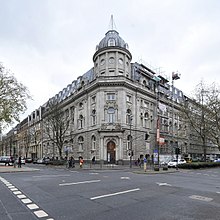Bergisch-Märkische Bank

The Bergisch-Märkische Bank is a former Universal Bank , which in 1871 in Elberfeld (today Wuppertal ) as a regional bank was established and an extensive branch network ( Aachen , Bielefeld , Bocholt , Bonn , Dusseldorf , Goch , Hagen , Hamm , Idar-Oberstein , Koblenz , Cologne , Krefeld , Lippstadt , Mönchengladbach , Neheim , Neuss , Opladen , Paderborn , Remscheid , Rheydt , Saarbrücken , Schwelm , Soest , Solingen , Trier , Velbert , Warburg , Ronsdorf and Zweibrücken ). In 1914 the bank and its branches in the Rhenish-Westphalian industrial area were taken over by Deutsche Bank .
The Bergisch-Märkische Bank was involved to a large extent in the financing of heavy industry in the Rhineland and Westphalia. She financed Hugo Stinnes and August Thyssen , among others .
The Bergisch-Märkische Bank built a new building for its Düsseldorf branch in 1905 based on designs by the Berlin architect Wilhelm Martens ; this building has been a listed building since 1983.
history
Bergisch-Märkische Bank was founded as a stock corporation in 1871 and in 1872 took over A. de Weerth & Co. in Elberfeld with its entire customer base. As a result of the founders' crash , the newly founded company was also able to take over the Düsseldorf branch of the insolvent Elberfeld Disconto- und Wechselbank in 1874. From 1889 the Bergisch-Märkische Bank was also active on the left bank of the Rhine after taking over two private banks in Aachen and Mönchengladbach . In 1893, after taking over two private banks based there, it was able to gain a foothold in Cologne .
In 1897, Deutsche Bank AG took a stake in Bergisch-Märkische Bank, which became a regional partner in West Germany.
The Bergisch-Märkische Bank took over:
- 1898 the Remscheider Bank AG in Remscheid
- 1901 the Goldschmidt & Cie. in Bonn and Robert Suermondt & Cie. in Aachen
- 1902 the Barmer Handelsbank AG in Barmen
- In 1904 three larger banks: the Trier Bank in Trier , the Lazard, Brach & Co. bank in Saarbrücken and the Padersteiner Bankverein in Paderborn with a branch in Warburg
- 1910 the Max Gerson & Co. KG bank in Hamm with a branch in Soest
- 1911 the Mülheimer Handelsbank in Mülheim am Rhein with a branch in Opladen
- 1912 the Neheimer Bankverein in Neheim
In 1914, the Bergisch-Märkische Bank was taken over by Deutsche Bank, shortly before another branch could be opened in Bielefeld . The merger with Deutsche Bank was mainly due to accounting reasons: This merger was intended to make the money invested as a stake available as real risk capital.
management
Hans Jordan was director of the bank from 1885 . Oscar Schlitter acted as general director from 1908 to 1912 and, after moving to Deutsche Bank AG, ran the takeover in 1914.
literature
- Gerald Spindler: Law and corporate groups: interdependencies of legal and corporate development in Germany and the USA between 1870 and 1933 , Mohr Siebeck, 1993, pp. 162–165 ( digitized )
- Lothar Gall, et al .: Die Deutsche Bank, 1870-1995 , CH Beck, 1995, ( digitized )
- Georg Solmssen - a German banker: letters from half a century 1900-1956 , CH Beck, 2012, ( digitized )